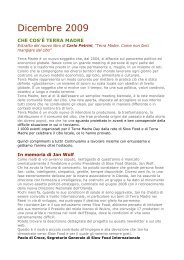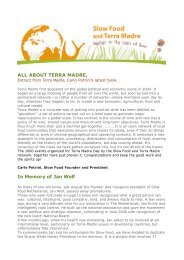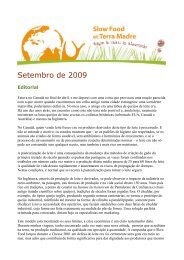all the food that's fit to print The Education Issue - Slow Food
all the food that's fit to print The Education Issue - Slow Food
all the food that's fit to print The Education Issue - Slow Food
You also want an ePaper? Increase the reach of your titles
YUMPU automatically turns print PDFs into web optimized ePapers that Google loves.
BOOKS<br />
SLOW READS<br />
In Defense of <strong>Food</strong>: An Eater’s Manifes<strong>to</strong><br />
By Michael Pollan<br />
Penguin Press<br />
Good <strong>Food</strong> Tastes Good: An Argument<br />
for Trusting Your Senses and Ignoring <strong>the</strong><br />
Nutritionists<br />
by Carol Hart<br />
SpringStreet Books<br />
If you have not yet read<br />
Michael Pollan’s new book,<br />
you’ve probably heard of it.<br />
His koan of an advisory—“Eat<br />
<strong>food</strong>. Not <strong>to</strong>o much. Mostly<br />
plants.”—has already made<br />
its way <strong>to</strong> most <strong>Slow</strong> <strong>Food</strong><br />
members’ ears, if not also <strong>the</strong>ir<br />
hearts and bellies. Health and<br />
science journalist Hart covers<br />
much of <strong>the</strong> same ground as<br />
Pollan, and though her book<br />
lacks <strong>the</strong> visibility of his, it shares <strong>the</strong> same over<strong>all</strong><br />
<strong>the</strong>sis. Both books argue for <strong>the</strong> simple, delicious,<br />
and health-giving properties of real, slow <strong>food</strong>, and<br />
against <strong>the</strong> reductionist vision of “nutritionism,” which<br />
breaks <strong>food</strong>s down in<strong>to</strong> <strong>the</strong>ir component parts. Pollan<br />
very clearly explicates <strong>the</strong> process: <strong>food</strong>s are highly<br />
processed, stripped of <strong>the</strong>ir natural nutrients along <strong>the</strong><br />
way, <strong>the</strong>n fortified afterwards <strong>to</strong> bring <strong>the</strong> lost nutrients<br />
back. However, <strong>the</strong> problem with thinking of nutrients<br />
as individual silver bullets is that it does not take in<strong>to</strong><br />
account <strong>the</strong> holistic interplay that is at work in a whole<br />
<strong>food</strong>. Both authors chart <strong>the</strong> his<strong>to</strong>ry of how we got in<strong>to</strong><br />
this way of thinking and <strong>the</strong>n try <strong>to</strong> help dig us out.<br />
Pollan’s book is a manifes<strong>to</strong> and <strong>the</strong>refore gives<br />
<strong>the</strong> reader general guidelines that can light <strong>the</strong> way:<br />
“Avoid <strong>Food</strong> Products that Make Health Claims” (a<br />
yam is silent because it has no wrapper on which<br />
<strong>to</strong> advertise its health bene<strong>fit</strong>s). Hart’s book is more<br />
nuts and bolts, with concrete advice such as how <strong>to</strong><br />
choose <strong>the</strong> healthiest piece of fruit in <strong>the</strong> pile (a few<br />
blemishes are a good sign, as is moderate size). Both<br />
books debunk various nutrition myths—although<br />
Hart goes more in depth with this, addressing many<br />
different specific health fads and claims—giving us<br />
<strong>the</strong> science, reasoning, and his<strong>to</strong>ry <strong>to</strong> support what<br />
we already know: <strong>to</strong>o much of any one thing is never<br />
a good idea, farm-fresh <strong>food</strong> is good and good for you,<br />
and eating <strong>food</strong> you’ve cooked yourself is <strong>the</strong> best way<br />
<strong>to</strong> eat healthily (only try not <strong>to</strong> eat so much, you hear?).<br />
—Jerusha Klemperer<br />
Sharing <strong>the</strong> Harvest: A Citizen’s Guide <strong>to</strong><br />
Community Supported Agriculture<br />
By Elizabeth Henderson and Robyn Van En<br />
Chelsea Green<br />
Increasingly Americans are<br />
waking up <strong>to</strong> <strong>the</strong> fact that<br />
we have become a nation<br />
out of <strong>to</strong>uch with <strong>the</strong> land<br />
that provides our <strong>food</strong>—and<br />
consequently <strong>the</strong> farmers<br />
who grow it. But what do<br />
we do about it? Apart from<br />
growing your own vegetables,<br />
participating in community<br />
supported agriculture (CSA)<br />
is one of <strong>the</strong> most effective<br />
ways of sharing in both <strong>the</strong> risks and rewards of farming.<br />
In Sharing <strong>the</strong> Harvest, Elizabeth Henderson takes up<br />
<strong>the</strong> reins from <strong>the</strong> late Robyn Van En, a key figure in<br />
forming <strong>the</strong> CSA movement in North America in <strong>the</strong><br />
mid-1980s. Henderson’s book honestly sums up <strong>the</strong> truth<br />
about starting and maintaining a CSA. Since each CSA is<br />
unique and has distinct operational demands, Henderson<br />
provides detailed anecdotes compiled from dozens of CSAs<br />
around <strong>the</strong> country describing <strong>the</strong> pitf<strong>all</strong>s and ch<strong>all</strong>enges<br />
of running a CSA, along with techniques and wisdom for<br />
overcoming difficulties.<br />
Sometimes it’s <strong>the</strong> simplest wisdom that makes <strong>the</strong><br />
biggest difference. For example, communication between<br />
<strong>the</strong> farmer and CSA members is important, whe<strong>the</strong>r by way<br />
of newsletters or increasing signage amongst <strong>the</strong> lettuces.<br />
She explains share pricing and bookkeeping technologies,<br />
gives examples of harvesting and distribution methods,<br />
and even ventures in<strong>to</strong> nitty-gritty details on hard-truth<br />
issues like divorce in farming families and how it affects<br />
a CSA.<br />
Henderson believes in <strong>the</strong> power of a community<br />
uniting <strong>to</strong> grow <strong>food</strong>, and she easily imparts that spirit <strong>to</strong><br />
<strong>the</strong> reader. If you’ve never heard of CSA, her enthusiasm<br />
will make you a believer; if you’re looking <strong>to</strong> start one in<br />
your community or if you’re a farmer needing guidance<br />
on managing a CSA, this book is an indispensable<br />
resource. —Elizabeth Bird 19<br />
<strong>The</strong> snail | spring 2008







